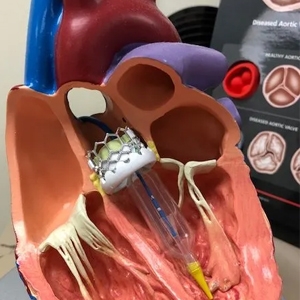
The Aortic Valve separates the left ventricle of the heart from the aorta. Hence, it is the valve that affects the flow of blood from the heart to the rest of the body. Multiple disease processes affect this valve mostly leading to Aortic Stenosis with obstruction to the flow of blood out of the heart, or Aortic Regurgitation with leakage of blood back to the heart. At times, infection of the valve leaflets takes place causing it to be dysfunctional.
Patients may be without symptoms for quite a while. Others though may develop shortness of breath, chest pains or syncope among other presenting signs secondary to their aortic valve disease. Aortic valve disease should be investigated in any patient with symptoms of heart failure or those presenting with a stroke or transient ischemic attack.
Typically, the disease is best seen by echocardiography, which is an ultrasound of the heart looking in particular to the valves and heart muscle. Cardiac catheterization which shows the blood flow to the heart and its vessels maybe helpful and is required before any intervention is done on the valve.
Treatment of aortic valve diseases could be medical, minimally invasive with catheter based interventions or open surgical ( Dr. Tamim ). Medical treatments could be attempted in certain scenarios, but when it fails, then valve replacement is indicated. The diseased valve is replaced by a new valve using catheters or open surgical techniques. Nowadays, we used Pig or cow based valves in most of the times. Purely mechanical valves are used less . Most importantly, the treatment should be tailored to the patient’s overall condition and wishes.
If you have an abnormal aortic valve, please go to MyUSADr. Second Medical Opinion to get a Personalized objective medical opinion from US based Expert physician!
Wael Tamim, MD, FACS
Cardiothoracic Surgeon

